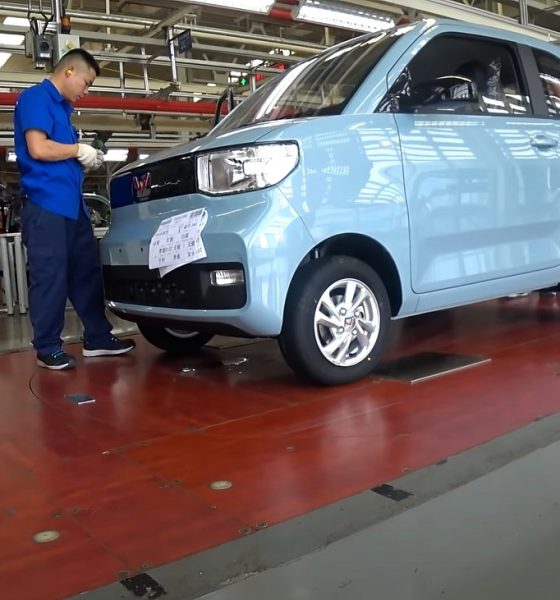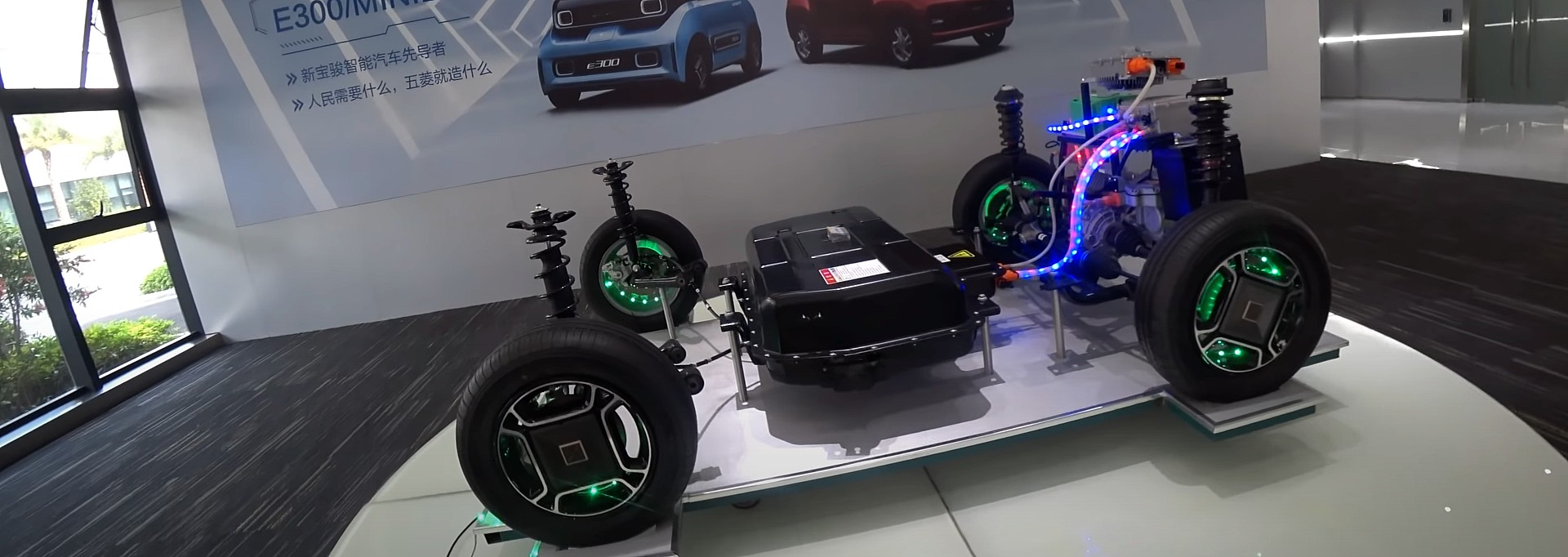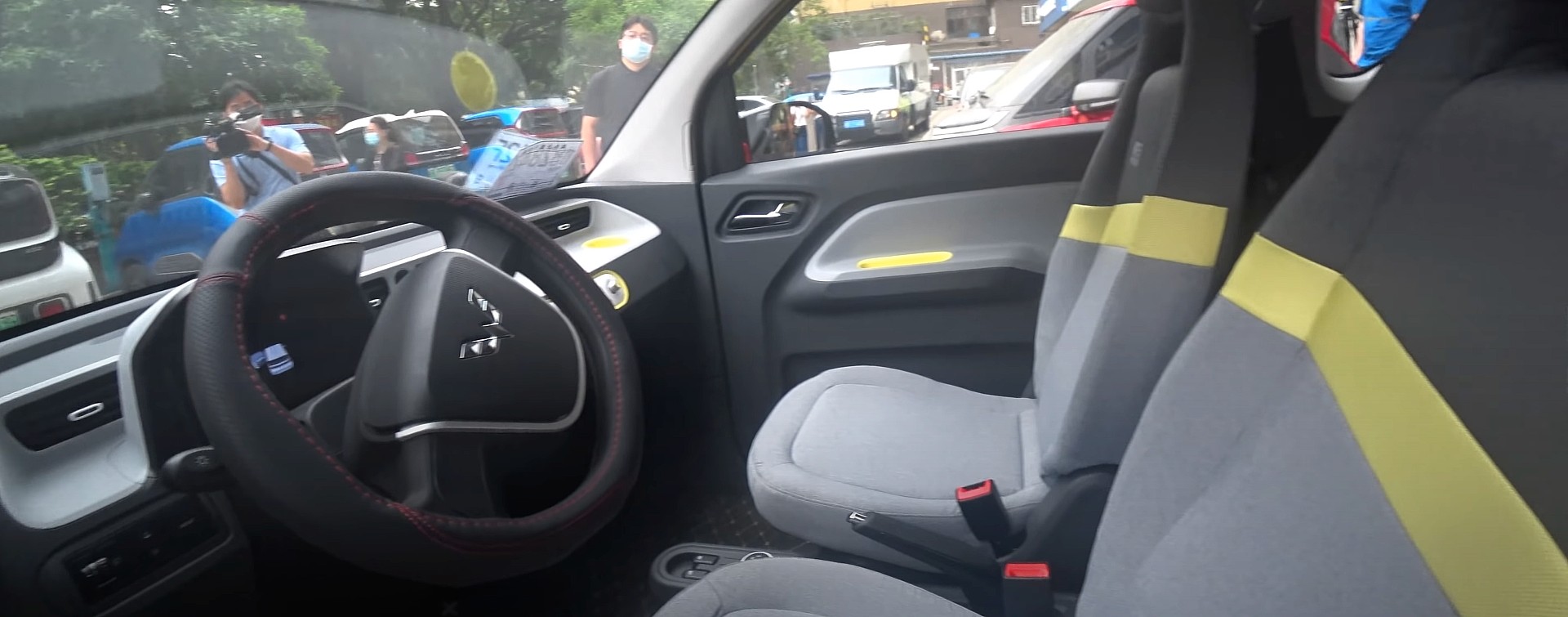

News
Tesla’s biggest rival in China: an in-depth look at the $4,200 Wuling HongGuang Mini EV
Tesla’s biggest rival in China is the Wuling HongGuang Mini EV that starts at around $4,200. Information regarding this small but impressive electric car that is a part of an SAIC, General Motors, and Wuling joint venture is vague and usually hard to come by. However, a recent video revealed several new details about the one car that has managed to outsell Tesla for the past five months.
The HongGuang Mini EV: A Quick Introduction
First delivered in July 2020, the Wuling HongGuan Mini EV is manufactured in Lizhou, Guangxi, China, and is available in two variants: one equips a 9.2 kWh battery and the other a 13.8 kWh battery. Capable of a 62 MPH top speed and only around 75 and 110 miles of range per charge, the vehicle’s base model is available for a respectable $4,200. However, a top price of around $5,600 will give you a fully-loaded version of the car complete with air conditioning and power windows, two features that are available in most cars as a standard option. This car, however, is far from standard and is an economical EV made for short trips, tight finances, and efficiency. It’s no Tesla, but it did secure over 119,250 total sales in 2020 alone, making it the second best-selling EV in the Chinese market, trailing the Tesla Model 3.
2021 has proven to be a different story, at least so far. The HongGuang Mini EV has commanded the Chinese electric vehicle sector in 2021, selling just shy of 57,000 units through February and holding a commanding lead over the second-place Model 3, which has accumulated 27,531 total sales so far this year. The affordability of the HongGuang Mini EV is proving to be a disruptor. Although it doesn’t pack the punch or performance of the Model 3, people continue to purchase the car because of its impressive price tag.
Production of the HongGuang Mini EV
As previously mentioned, the Mini EV is produced in Lizhou, Guangxi, at a small but extremely efficient facility. A new car rolls off the line every minute, and the vehicle only takes 4 hours to produce from start to finish, according to YouTuber Gwelio 60, who recently toured the factory to have an inside look at the car.
An assembly line worker at the Wuling plant. He is putting the finishing touches on the HongGuang Mini EV here. (Credit: YouTube | Gweilo 60)
There are not many parts to the car, and it is a relatively simple machine. The battery and some other basic parts that make up a car are really the only things that go under the body and chassis itself. Anything that could be considered a “luxury” is not included in the vehicle’s most basic models. It is really a car to get from point A to point B with as few issues or bells and whistles as possible.
(Credit: YouTube | Gweilo 60)
The vehicle itself is an employee at the plant. In fact, several of them are. Wuling has several HongGuang Mini EVs that haul materials, parts, and other things across the campus of the production facility completely autonomously. The cars operate under their own guidance and can sense when to stop and when to accelerate back onto their path. Gweilo 60 showed an example of how safe they are in the video by crossing the street while a HongGuang Mini EV approached. The car successfully stopped, waited for Gweilo to cross the street, and began navigating once again.
The Interior: Simple, small, and smooth
The bells and whistles are not present in this vehicle. A small dash screen and a simple radio, along with HVAC ventilation, make up the entirety of the dashboard. It is comfortable, small, sleek, and smooth, and it is just enough to keep someone comfortable during their short drive. It isn’t much, but with the low range, it’s not like someone needs excessive entertainment or features. You get what you pay for.

(Credit: YouTube | Gweilo 60)
The ride is smooth, zippy, and comfortable, according to the short review from Gweilo. It won’t go over 62 MPH, but it’s another gas car off the road, something that is always a positive. It has good suspension, it handles well, and it is a comfortable ride for any occupants, he says.
The Bottom Line: Is the Wuling HongGuang Mini EV a real “threat” to Tesla?
No, it probably isn’t a threat to Tesla because Tesla’s cars and the Wuling HongGuang Mini EV simply are not in the same realm. Comparing the car to the Model 3 is like comparing the Model 3 to the Rivian R1T: prices, purpose, and functionality are all different, and they are two cars that shouldn’t be mentioned in the same sentence. Many Tesla enthusiasts have called the Mini EV a “golf cart” because of its size and price point, and really that isn’t far off. However, the Mini EV is undoubtedly a popular vehicle, and the sales figures show that. Is it a legitimate threat to Tesla? Probably not. At least, it doesn’t seem that way. They’re just not comparable.
Tesla to sell zero cars in China by 2030, Morgan Stanley’s Jonas says
That isn’t to say that what Wuling has accomplished with this small but mighty EV isn’t impressive. The sales figures alone are incredible, and it is certainly a great indication that China is ready to buy EVs. However, it would be interesting to see if the Wuling-GM-SAIC partnership would be willing or would plan for a more competitive, luxurious, and expensive EV that would drive competition to the max in the Chinese market. China is becoming a hotbed for EVs, and the Wuling HongGuang Mini EV is driving EV sales through the roof.
Watch Gweilo 60’s full video regarding the Wuling HongGuang Mini EV below.

Elon Musk
Elon Musk and Tesla AI Director share insights after empty driver seat Robotaxi rides
The executives’ unoccupied tests hint at the rapid progress of Tesla’s unsupervised Robotaxi efforts.

Tesla CEO Elon Musk and AI Director Ashok Elluswamy celebrated Christmas Eve by sharing personal experiences with Robotaxi vehicles that had no safety monitor or occupant in the driver’s seat. Musk described the system’s “perfect driving” around Austin, while Elluswamy posted video from the back seat, calling it “an amazing experience.”
The executives’ unoccupied tests hint at the rapid progress of Tesla’s unsupervised Robotaxi efforts.
Elon and Ashok’s firsthand Robotaxi insights
Prior to Musk and the Tesla AI Director’s posts, sightings of unmanned Teslas navigating public roads were widely shared on social media. One such vehicle was spotted in Austin, Texas, which Elon Musk acknowleged by stating that “Testing is underway with no occupants in the car.”
Based on his Christmas Eve post, Musk seemed to have tested an unmanned Tesla himself. “A Tesla with no safety monitor in the car and me sitting in the passenger seat took me all around Austin on Sunday with perfect driving,” Musk wrote in his post.
Elluswamy responded with a 2-minute video showing himself in the rear of an unmanned Tesla. The video featured the vehicle’s empty front seats, as well as its smooth handling through real-world traffic. He captioned his video with the words, “It’s an amazing experience!”
Towards Unsupervised operations
During an xAI Hackathon earlier this month, Elon Musk mentioned that Tesla owed be removing Safety Monitors from its Robotaxis in Austin in just three weeks. “Unsupervised is pretty much solved at this point. So there will be Tesla Robotaxis operating in Austin with no one in them. Not even anyone in the passenger seat in about three weeks,” he said. Musk echoed similar estimates at the 2025 Annual Shareholder Meeting and the Q3 2025 earnings call.
Considering the insights that were posted Musk and Elluswamy, it does appear that Tesla is working hard towards operating its Robotaxis with no safety monitors. This is quite impressive considering that the service was launched just earlier this year.
Elon Musk
Starlink passes 9 million active customers just weeks after hitting 8 million
The milestone highlights the accelerating growth of Starlink, which has now been adding over 20,000 new users per day.

SpaceX’s Starlink satellite internet service has continued its rapid global expansion, surpassing 9 million active customers just weeks after crossing the 8 million mark.
The milestone highlights the accelerating growth of Starlink, which has now been adding over 20,000 new users per day.
9 million customers
In a post on X, SpaceX stated that Starlink now serves over 9 million active users across 155 countries, territories, and markets. The company reached 8 million customers in early November, meaning it added roughly 1 million subscribers in under seven weeks, or about 21,275 new users on average per day.
“Starlink is connecting more than 9M active customers with high-speed internet across 155 countries, territories, and many other markets,” Starlink wrote in a post on its official X account. SpaceX President Gwynne Shotwell also celebrated the milestone on X. “A huge thank you to all of our customers and congrats to the Starlink team for such an incredible product,” she wrote.
That growth rate reflects both rising demand for broadband in underserved regions and Starlink’s expanding satellite constellation, which now includes more than 9,000 low-Earth-orbit satellites designed to deliver high-speed, low-latency internet worldwide.
Starlink’s momentum
Starlink’s momentum has been building up. SpaceX reported 4.6 million Starlink customers in December 2024, followed by 7 million by August 2025, and 8 million customers in November. Independent data also suggests Starlink usage is rising sharply, with Cloudflare reporting that global web traffic from Starlink users more than doubled in 2025, as noted in an Insider report.
Starlink’s momentum is increasingly tied to SpaceX’s broader financial outlook. Elon Musk has said the satellite network is “by far” the company’s largest revenue driver, and reports suggest SpaceX may be positioning itself for an initial public offering as soon as next year, with valuations estimated as high as $1.5 trillion. Musk has also suggested in the past that Starlink could have its own IPO in the future.
News
NVIDIA Director of Robotics: Tesla FSD v14 is the first AI to pass the “Physical Turing Test”
After testing FSD v14, Fan stated that his experience with FSD felt magical at first, but it soon started to feel like a routine.

NVIDIA Director of Robotics Jim Fan has praised Tesla’s Full Self-Driving (Supervised) v14 as the first AI to pass what he described as a “Physical Turing Test.”
After testing FSD v14, Fan stated that his experience with FSD felt magical at first, but it soon started to feel like a routine. And just like smartphones today, removing it now would “actively hurt.”
Jim Fan’s hands-on FSD v14 impressions
Fan, a leading researcher in embodied AI who is currently solving Physical AI at NVIDIA and spearheading the company’s Project GR00T initiative, noted that he actually was late to the Tesla game. He was, however, one of the first to try out FSD v14.
“I was very late to own a Tesla but among the earliest to try out FSD v14. It’s perhaps the first time I experience an AI that passes the Physical Turing Test: after a long day at work, you press a button, lay back, and couldn’t tell if a neural net or a human drove you home,” Fan wrote in a post on X.
Fan added: “Despite knowing exactly how robot learning works, I still find it magical watching the steering wheel turn by itself. First it feels surreal, next it becomes routine. Then, like the smartphone, taking it away actively hurts. This is how humanity gets rewired and glued to god-like technologies.”
The Physical Turing Test
The original Turing Test was conceived by Alan Turing in 1950, and it was aimed at determining if a machine could exhibit behavior that is equivalent to or indistinguishable from a human. By focusing on text-based conversations, the original Turing Test set a high bar for natural language processing and machine learning.
This test has been passed by today’s large language models. However, the capability to converse in a humanlike manner is a completely different challenge from performing real-world problem-solving or physical interactions. Thus, Fan introduced the Physical Turing Test, which challenges AI systems to demonstrate intelligence through physical actions.
Based on Fan’s comments, Tesla has demonstrated these intelligent physical actions with FSD v14. Elon Musk agreed with the NVIDIA executive, stating in a post on X that with FSD v14, “you can sense the sentience maturing.” Musk also praised Tesla AI, calling it the best “real-world AI” today.








